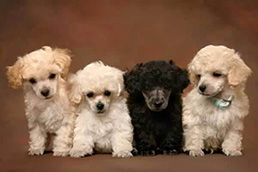Poodle Puppies for Sale Miami

With the purchase of your puppy:
- 14 days of warranty
- 1 year warranty
- Health Certificate
- Deworming
- Shots- to date
- 1st Vet Visit
- Registration Papers
- Dog Training
History
The poodle is believed to have originated in Germany, where it was known as the Pudelhund. Pudel (cognate with the English word “puddle”), is derived from the Low German verb meaning “to splash about”, and the word Hund in German means “dog” (cognate with “hound”). The breed was standardized in France, where it was commonly used as a water retriever.
The European mainland had known the poodle long before it was brought to England. Drawings by German artist Albrecht Dürer established the popular image of the breed in the 15th and 16th centuries. It was the principal pet dog of the late 18th century in Spain, as shown by the paintings of the Spanish artist Francisco Goya. France had toy poodles as pampered favorites during the reign of Louis XVI at about the same period.
The poodle has been bred in at least three sizes, including Standard, Miniature, and Toy. According to the American Kennel Club, the Standard Poodle is the oldest of the three varieties, and was later bred down to the miniature and toy sizes. Despite the Standard Poodle’s claim to greater age than the other varieties, some evidence shows the smaller types developed only a short time after the breed assumed the general type by which it is recognized today. The smallest, or Toy variety, was developed in England in the 18th century.
Appearance
The poodle is a very active, intelligent and elegant dog, squarely built, and well proportioned. To ensure the desirable squarely built appearance, the length of body measured from the breastbone to the point of the rump approximates the height from the highest point of the shoulders to the ground. The eyes should be very dark, oval in shape, and have an alert and intelligent expression. The ears should fold over close to the head, set at, or slightly below, eye level. The coat should be of naturally curly texture, dense throughout, although most AKC-registered show dogs have a lion-cut or other, similarly shaven look.
Colors
Poodles have either a solid-colored or parti-colored coat. The dogs have a wide variety of coloring, including white, black, brown, parti, silver, gray, silver beige, apricot, red, cream, sable, and patterns such as phantom and brindle.
For solid-colored poodles, the coat is an even and solid color at the skin. In blues, grays, silvers, browns, cafe-au-laits, apricots and creams, the coat may show varying shades of the same color. This is frequently present in the somewhat darker feathering of the ears and in the tipping of the ruff. While clear colors are preferred by registries, such natural variation in the shading of the coat is not to be considered a fault. Brown and cafe-au-lait poodles have liver-colored noses, eye rims and lips, dark toenails and dark amber eyes. Black, blue, gray, silver, cream and white poodles have black noses, eye rims and lips, black or self-colored toenails and very dark eyes. In the apricots, while the foregoing coloring is preferred, liver-colored noses, eye rims and lips, and amber eyes are permitted, but are not desirable. Incomplete color of nose, lips and eye rims, or a “mismatched” color are considered faults by registries.
Wikipedia
